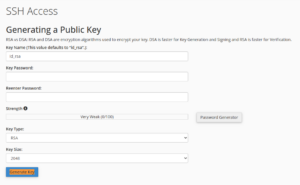Most people manage their websites through the cPanel interface. But sometimes, using the command line can offer more control, especially when uploading files, running maintenance tasks, or troubleshooting errors.
That’s where SSH (Secure Shell) access comes in.
In this article, we’ll walk you through how to enable and use SSH access in your cPanel hosting account even if you’ve never used a terminal before.
What Is SSH?
SSH stands for Secure Shell. It allows you to access your hosting account’s files and run commands using a text-based interface.
Think of it like a “remote keyboard” into your hosting space. You can:
-
View and manage files
-
Check logs
-
Run WordPress commands (via WP-CLI)
-
Fix file permission issues
-
Unzip or move large folders quickly
Is SSH Safe?
Yes SSH uses encryption to make sure no one can intercept your login or data. It’s much more secure than traditional FTP when used correctly.
But because it’s powerful, most hosting providers disable it by default until you enable it manually.
Step 1: Enable SSH Access in cPanel
-
Log in to cPanel
Use the credentials provided by your host. -
Find the “Terminal” or “SSH Access” Option

-
Search for “SSH Access” or navigate to the Security section.
-
If you don’t see this, your hosting plan might not include SSH. Contact your hosting support to request it.
-
-
Manage SSH Keys
Click Manage SSH Keys (or Generate a New Key if none exists).

Step 2: Generate an SSH Key (If Required)
-
In the SSH Access section, click Manage SSH Keys.
-
Click Generate a New Key:

-
Choose a key name or leave it default
-
Set a secure password (optional)
-
Click Generate Key

-
-
Authorize the key by clicking Manage > Authorize next to the key you just generated.
Step 3: Connect via SSH
You can now connect to your hosting account using a terminal tool. Depending on your operating system:
Windows:
Use PuTTY — a free terminal client.
-
Download and install PuTTY
-
Enter your domain name or server IP under Host Name
-
Port:
22 -
Click Open
-
Log in with your cPanel username and password
macOS / Linux:
These systems have a terminal built-in. Just open Terminal and type:
Replace username with your cPanel username and yourdomain.com with your domain or server IP.
Common SSH Commands Beginners Can Use
Once you’re connected, here are some useful commands:
| Command | What It Does |
|---|---|
ls |
Lists files and folders |
cd foldername |
Change directory |
pwd |
Shows current directory path |
rm filename |
Delete a file |
mkdir newfolder |
Creates a new folder |
unzip file.zip |
Unzips a .zip file |
du -sh * |
Shows disk usage for folders |
wp plugin list |
(If WP-CLI is enabled) List all plugins |
What Not to Do as a Beginner
-
Don’t delete files you don’t recognize
-
Avoid changing permissions unless you understand what they do
-
Don’t run random commands copied from the internet
If in doubt, ask your host before using commands that modify files or folders.
Optional: Use SSH to Run WordPress Commands (WP-CLI)
If your host supports WP-CLI, you can manage WordPress from the terminal:
Examples:
This is useful if you can’t access the WordPress admin panel due to errors or conflicts.
Troubleshooting SSH Access
-
“Connection refused” – Port 22 might be blocked by your firewall or SSH not enabled
-
“Permission denied” – Wrong username or password
-
Key not working? – Check if it’s authorized in the SSH Keys section in cPanel
Still having issues? Contact your host and confirm:
-
SSH is enabled
-
Your IP is not blocked by the firewall
Final Thoughts
SSH might seem intimidating at first, but it becomes incredibly useful once you understand the basics. From running quick commands to fixing broken sites, SSH gives you a reliable toolset especially when you can’t fix things through the regular cPanel interface.
Start small, stick to safe commands, and you’ll quickly build confidence using the terminal.





 ajith
ajith  June 26, 2025
June 26, 2025